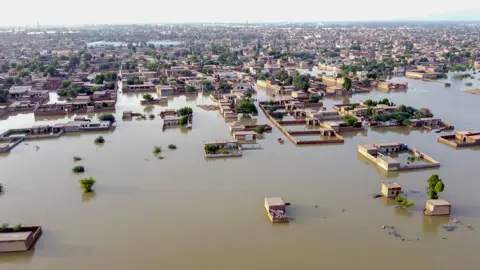Pakistan's Climate Crisis: A Call for Resilience and Global Support
From the mountainous regions in the north to the Indus Delta, Pakistan has a fragile ecosystem. In 2022, Pakistan got a reality check with an unprecedented flood that inundated one-third of the country's land mass, affecting over 33 million people and causing an economic loss of over $30 billion.
I've seen many humanitarian disasters in the world, but I have never seen climate carnage on this scale. — António Guterres, United Nations Secretary-General

The recent monsoon season has claimed hundreds of lives with intense rainfall and more frequent cloud bursts. Pakistan got its wakeup call in 2022 when devastating floods killed more than 1,700 people, but it's not clear lessons have been learned. Officials here will tell you the situation is under control. But when you ask the people, they will tell you otherwise.
Resource Allocation and Climate Vulnerability
Pakistan continues to allocate the bulk of its limited resources to defense, citing external threats to sovereignty. This leaves little for development, welfare, and safeguarding its growing population from existential challenges.
I think we don't even have enough money to spend on military if you compare us with our region. The point is that Pakistan faces these catastrophic disasters on its own. Even after 2020, most of the money that came to Pakistan was in the shape of loans. There was no international funding that was given to Pakistan. Pakistan's own footprint in the greenhouse gas emissions is less than 1%. But it's the seventh most vulnerable country.
The World Bank has said that Pakistan needs about $340 billion plus for adaptation. But there is no international financing available for the Global South to face climate change. Critics and environmentalists accuse the government of tall promises yet remain hopeful that the floods have raised public awareness about climate change and its consequences.
Before the 2010 floods, climate change was barely understood and seen as divine punishment. Today, awareness has grown and children discuss global warming. Tree planting is promoted and despite government neglect, there is hope this challenge can be overcome. — Huma Shakir, Climate Activist

The Path Forward
Three years on, Pakistan finds itself at the same crossroads, but will need tens of billions of dollars to build climate-resilient infrastructure and formulate sustained policies to avert future loss to mitigate the effects of global warming and climate change.
The journey towards resilience requires not only domestic policy reform but also international cooperation and funding. As Pakistan grapples with its fragile ecosystem and recurring climate disasters, the global community must step up to support one of the world's most vulnerable nations.


0 Comments